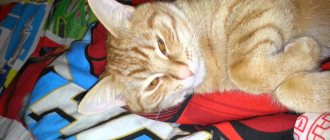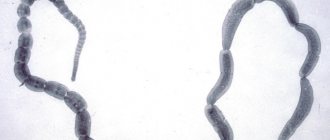In what cases is it recommended to euthanize a cat?
There are strict indications for euthanasia. No professional doctor will kill an animal at the momentary whim of the owner, just because the cat is deaf/blind, defecates in the wrong place or meowed heart-rendingly during the last heat.
Any medical procedure has its own indications, and the same applies to our question. The main reasons for euthanasia are the quality of life of a cat when no painkillers or medications can alleviate the physical suffering of the animal, and the prognosis for the outcome of the disease is unfavorable. These conditions include:
- oncology in the final stages of development or tumors that disrupt the functioning of organs and systems;
- injuries incompatible with life;
- in some cases, old age contributes to a positive decision.
As for traumatic pathologies, the issue of euthanasia is approached with special care and after a full, competent examination of the animal. No one argues that with multiple fractures, tissue ruptures or bruises, a cat experiences pain and suffering, but, as a rule, after proper treatment, health is restored and life continues.
A striking example is the story that happened with one of the yard cats. After the accident, his jaw was crushed and his skull was fractured. The owners, wanting to get rid of the burden, threw the poor fellow into nearby bushes in the hope of his quick death. Imagine their surprise when a few days later the dying pet crawled under the door, begging for help. There was nothing left to do but start treatment. Surprisingly, the cat got out!
The decision to artificially kill a pet is made only after examining the animal and with full confidence in the hopelessness of the situation!
How cats are euthanized
Author KakSimply!
If a cat is terminally ill and treatment does not bring results, then a veterinarian can alleviate the animal’s suffering in a humane way. This method is called euthanasia. The medical term is euthanasia.
Indications for euthanizing a cat may be late-stage cancers and other incurable diseases from which the animal experiences only pain and suffering. The decision to euthanize his animal is made only by the owner; the veterinarian offers this method of alleviating suffering after all treatment options for the cat have been tried .Euthanasia of an animal can only be carried out in specialized institutions or veterinary clinics, where this procedure is authorized by higher authorities. This procedure is performed by a veterinarian. If the owner’s decision to euthanize the cat is firmly made, then he signs a written consent. The document explains what euthanasia is, describes the operation itself and that the owner agrees to it. Euthanasia of a cat can also be prescribed for old animals that refuse to eat on their own due to exacerbation of chronic diseases.
If the owner of the animal does not have the opportunity to take the cat to the clinic, then you can call a specialist at home. The entire euthanasia procedure will take place in the same sequence, only at home.
The procedure itself must take place in several stages. First, an injection of a muscle relaxant is given, which will make the animal completely relaxed. After a few minutes, basic anesthesia can be administered, and the cat will experience complete loss of sensitivity to the environment. At the same time, she does not feel anything and does not hear those around her.
Some older animals experience cardiac and respiratory arrest at this stage of euthanasia. If anesthesia is administered intravenously, the doctor may overdose and the cat will die under anesthesia.
READ What is the character of British cats?
The next stage of euthanasia involves injecting a drug into the heart muscle, which immediately stops the heart. At the same time, the cat does not feel anything.
After all the euthanasia procedures have been completed, the doctor listens to the heart with a stethoscope. After the last injection, the cat may have some reflex movements. Putting a cat to sleep is a psychological trauma for the owner of the animal, you need to be prepared for psychological changes, for this you can take relatives with you who will support and reassure the cat owner.
The method of euthanasia depends on the disease and age of the cat and is prescribed by the veterinarian independently. At the request of the owners, the cat's corpse is cremated or given away for independent burial.
If the cat's owner cannot pick up the animal's corpse, then he has the right to leave it at the veterinary clinic; the disposal of the animal will be carried out at state expense.
Methods of painless euthanasia
First, the pet owner must sign the necessary documents confirming his consent to euthanasia. Then choose a method of euthanasia. There are several of them. However, the most humane and painless is medication. This type of euthanasia is used in almost all public and private veterinary clinics.
Important! Only a specialist can painlessly euthanize a cat at home! Independent actions can lead to a deterioration in the pet’s health, increased pain, spasms, and severe death.
To carry out the procedure, world organizations recommend the use of anesthetics, relaxants and auxiliary pharmacological agents (Arduan, Thiopental, Droperidol, Lidocaine). These drugs do not cause painful death.
However, many clinics, in order to save money and speed up euthanasia, use other drugs that depress the nervous system and, if dosed incorrectly, lead to suffering for the animal. These include drugs such as Ditilin, Xylazine and others.
Painless euthanasia of cats is carried out using medications in several stages:
- The veterinarian administers the required dose of the drug (intravenously or intramuscularly).
- The cat falls into deep sleep and stops responding to external stimuli.
- The doctor administers an injection with a drug from the group of muscle relaxants. Gradually, cardiac activity stops and breathing stops.
- The heart is listened to using a phonendoscope (auscultation); an ultrasound scan, which is sometimes offered to confirm the fact of death, is usually not required.
How is the euthanasia procedure carried out in veterinary clinics?
Naturally, euthanasia should be carried out by a veterinarian and only him! But where exactly is up to the owner to decide: for a fee, a specialist will always come to your home. Ending your pet's life at home is perhaps a better solution, since the animal will not be subjected to additional stress. Typically, professionals do not allow the owner to be present at the killing, so as not to aggravate the client’s depressed state of mind.
There are also people who try to euthanize a cat at home without the help of a veterinarian. This is great stupidity and a reckless act! Purchasing safe medications on your own is problematic, and in some cases impossible. Using improvised means to stop breathing or the heart will cause agony in the cat, the sight of which not everyone can withstand.
And you certainly cannot resort to cruel methods of euthanasia: drowning, suffocation, electric shock, or the introduction of toxic (potent substances) into the body that are not capable of ensuring a painless departure to another world. Such actions are equivalent to murder!
Euthanasia reduces the death torment of animals, so it should be carried out in specialized clinics. In order for the cat to go on its final journey quickly and painlessly, it is necessary to choose qualified doctors who will carry out this procedure in accordance with all the rules. To avoid making a mistake with a clinic, you must:
- Find out about her reputation.
- Is there permission to carry out such a procedure?
- How experienced are doctors in this matter?
Also, if you have friends who have already encountered this unpleasant procedure, you can ask them for advice and find out which clinic they performed it in. If you go to the first clinic you come across, no one can give you a guarantee that the cat will be euthanized according to all the rules and will not have to suffer for a long time.
Euthanasia must occur in several stages. First of all, the animal is given a special injection, which should help the cat completely relax. This is called a muscle relaxant injection.
After a few minutes, anesthesia is administered, which blocks all pain in the cat. After this, there will be a complete shutdown of sensitivity to what is happening around and the cat will not hear or feel anything.
The last stage involves seeing a drug that stops the cat's heart. The medicine is injected into the heart muscle and after that the pet no longer feels anything. After this, the doctor listens to the heartbeat to make sure that the euthanasia was successful, but at the same time, the cat may still experience reflex movements for a few seconds.
Where to do euthanasia: at home or in a clinic
For an additional fee, today it is possible to carry out the procedure of euthanasia of an animal at home. There are positive and negative aspects to this.
On the one hand, the animal will not experience additional stress from a visit to the clinic and will die in its usual home environment, although if you regularly, during the cat’s life, visited the veterinary hospital with him for routine vaccinations or examinations, and the animal is calm about this , then this will be the best option.
For impressionable owners, euthanizing a pet at home may subsequently evoke unpleasant emotions and memories associated with the place and objects surrounding the cat during the procedure, although going to the clinic may feel like a betrayal towards the animal. Therefore, you need to prepare psychologically and choose a less painful option for yourself.
Having weighed the pros and cons, and decided on the place of euthanasia, the owner, despite the severity of the situation, needs to take care of the quality of the procedure itself so that it is carried out as humanely as possible.
Animal euthanasia and religion
Before euthanizing the animal, the animal is put under anesthesia.
The euthanasia procedure is divided into 2 stages: first, the animal is put under anesthesia, and then a special substance is injected that blocks the functioning of vital organs (heart and lungs) or the effect of the drug is gradually increased until the body’s vital functions completely stop – clinical death.
READ British Fold cats: description of the breed, character, care features
When choosing a veterinarian to carry out the killing, be sure to specify the drugs he uses. The fact is that there are several schemes, and not all of them can be called humane in relation to animals.
Under no circumstances should you agree to be euthanized using muscle relaxants (ditylin, xylazine, killin, etc.) without first using narcotics and painkillers. The principle of action of the drugs is to relax the muscles, including the muscles of the heart and lungs. The cat is conscious, feels pain, but cannot move. As a result, the apparently calm animal dies in terrible agony from suffocation.
Believers ask the question: can putting a cat to sleep be equated to a mortal sin? There is no clear answer. Some clergy believe that euthanasia is a sin and one cannot go against the will of God, who endowed a living being with suffering. Others, on the contrary, separating the souls of humans and animals, are of the opinion that cat euthanasia is a benefit that helps the pet get rid of worldly torment.
In any case, the heavy burden of deliberate deprivation of life lies on the shoulders of those who made the decision and those who carried it out. Only by acting according to the laws of conscience, being confident in the inevitability of the pathological process, can you achieve peace of mind and not worry about what you have done.
KotoDigest Thank you for subscribing, check your inbox: you should receive an email asking you to confirm your subscription
If a cat is terminally ill, and treatment does not bring any change for the better, a veterinarian can save the pet from suffering using a humane method, which in medicine is called euthanasia. By the way, you can learn from any specialist how a cat is euthanized, but not all owners can psychologically say goodbye to their four-legged friend forever, because This process is considered to be the most difficult in moral terms.
As already mentioned, the euthanasia of a cat, how this operation occurs and whether it is worth doing is decided by a specialist. The main reasons for euthanizing an animal are diseases such as late-stage oncology, incurable infections, obvious symptoms of rabies, chronic and severe illnesses that cause suffering to the pet.
As for the final decision regarding euthanizing the cat, it is made by the owner himself. The veterinarian should only suggest this option to alleviate the suffering of his four-legged friend after all treatment methods have been used.
Euthanasia is carried out by a veterinarian in a specially designated institution or veterinary clinic, where this procedure has permission issued by higher authorities.
If the owner has made the final decision to euthanize the animal, he must sign an agreement. This document explains what euthanasia is, describes the operation itself, and confirms that the person agrees to stop the cat's suffering using this humane method.
There are times when the owner, for some reason, cannot take the pet to the clinic. To solve this problem, a specialist is called to your home. The entire euthanasia process is carried out in the same sequence, only at home.
READ How to make DIY bee traps from fiberboard
As animals age, many chronic diseases tend to worsen. Therefore, quite often, experts prescribe euthanasia for old cats that are no longer able to take food on their own and are fading away before the owner’s eyes.
If we talk about the euthanasia process itself, it consists of several stages. Initially, the cat is given an injection, which leads to complete relaxation of the animal. Basic anesthesia is administered after a couple of minutes. At this moment, the pet experiences a complete loss of sensitivity to the outside world. The animal feels and hears nothing.
By the way, some already old cats may stop breathing and heart at this stage of euthanasia. When administering anesthesia intravenously, the veterinarian has the right to increase the dose, and the cat will die under anesthesia.
At the next stage of euthanasia, drugs are injected into the heart muscle, which immediately stops the heart. The cat does not feel anything at this moment.
Once all euthanasia procedures are completed, the doctor uses a stethoscope to listen to the heart. By the way, after the last injection the cat may experience some reflex movements.
It should be noted that the age of the cat and the type of disease affect the method of euthanasia, which the doctor prescribes independently.
After euthanasia, the animal’s body can be buried in a special cemetery, cremated, or disposed of at a biowaste disposal plant. The owner must decide for himself what to do with the dead pet. In addition, this process can be entrusted to a special organization that provides funeral services for pets, having all the necessary permissions from the authorities.
Highly qualified specialists never insist on euthanasia. They enable the owner to approach the situation soberly and think it through. The doctor also refers the cat for mandatory health diagnostics to other specialists and listens to their opinions. You should never rush into a final decision.
Finally, it is worth saying that euthanizing a beloved pet is quite a serious psychological trauma for the owner. Therefore, you need to prepare for such a difficult decision and the process itself. To do this, you should consult with all family members and morally support each other.
Preparations for euthanasia
American doctors, for euthanasia, use the drug “Euthanasin”, in Germany the drug “T-61”, which first “turns off consciousness”, after which they cause respiratory arrest and paralyze the heart muscle.
In our country, these drugs are prohibited; lethal doses of drugs are used for euthanasia:
- sedatives (xylazine);
- anesthetics (propofol, droperidol, sodium etaminal, sodium thiopental);
- muscle relaxants (arduan, ditilene);
- electrolytes (magnesium sulfate);
- antiarrhythmic (lidocaine).
Possible euthanasia schemes:
- Euthanasia using lethal doses of the above anesthetics. With this method, the animal falls asleep, there are no convulsions or agony, after some time breathing stops and then cardiac arrest occurs. Difficulties may arise due to the fact that these drugs are administered strictly intravenously, and with many diseases and serious conditions of the animal, intravenous administration can be difficult. Additionally, these drugs are not legally available to veterinarians. If the first method is not possible, use the second scheme.
- The usual intramuscular anesthesia is first administered, for example Rometar + Zoletil, and after losing consciousness, a drug for euthanasia is administered: Lidocaine, Magnesium sulfate, Ditilin.
These two methods ensure that the animal does not suffer in any way during the euthanasia process.
It is important for the pet owner to know:
- Euthanasia with Ditilin is carried out after the cat is put into a state of deep anesthesia. Otherwise, Ditilin causes painful death from suffocation, and, all this time, the animal is conscious;
- Magnesium sulfate – the use of magnesium sulfate accompanies the development of vascular spasm and subsequently paralyzes the respiratory center, resulting in respiratory arrest and death. Should also be used after anesthesia;
- Lidocaine is a strong local anesthetic and a drug that affects the automatism of the cardiac sinus node and the conductivity of the heart muscle. During euthanasia, lidocaine causes bradycardia and cardiac arrest. Before administering the drug, the animal must be anesthetized.
Cat euthanasia: issues of humanity
There is no need to explain to anyone what euthanasia is? But just in case, it’s worth mentioning the concept: euthanasia is the deliberate killing of an animal with the help of medications.
In our country, there is no law on the rules for euthanizing a cat, with the exception of poorly functioning legislation on cruelty to animals. Despite the imperfection of the system, a person must always remain human and understand that the procedure is humane only in the case when a pet is deprived of life for health reasons: severe pain and suffering incompatible with life. In all other cases, euthanasia is a crime!
How does the euthanasia process work?
In our country there are no such high-quality drugs approved for use for euthanasia as in some foreign countries. Therefore, for humane reasons, in order to prevent any suffering or discomfort in the animal during the procedure, euthanasia should take place in two stages.
First, an injection of a drug is used to put the animal into a deep narcotic sleep, and then an injection of one of the drugs that has a toxic effect, which paralyzes the respiratory center and causes cardiac arrest.
A competent doctor will allow the owner to be present during the administration of anesthesia, and will make the final injection, asking the owner to wait for the end of the procedure in another room.
Many doctors perform euthanasia without prior anesthesia; such euthanasia of an animal cannot be called completely painless for the patient; in this case, the cat will be conscious, feel suffocation and panic, but will not be able to move, since euthanasia drugs relax muscles and impair respiratory function .
Therefore, despite the doctor’s assurances, demand the administration of anesthesia before euthanasia, so you will be sure that the animal really “fell asleep” and did not experience any suffering.











